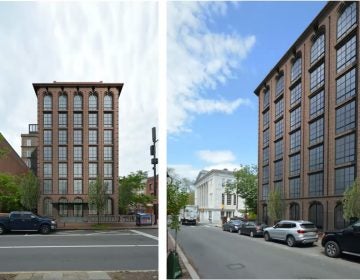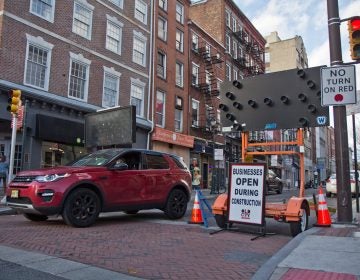DiCicco overlay gets more mixed reviews

Mar. 25, 2009
By Kellie Patrick Gates
For PlanPhilly
A waterfront advisory group remains concerned that a proposed zoning overlay doesn’t do enough to protect public access to the riverfront and preserve the goals of the Action Plan for the Central Delaware.
The current legislation proposed by City Councilman Frank DiCicco does not ensure a wide-enough swath of green space between the river and future development, members of the Central Delaware Advisory Group said at a Wednesday morning meeting with DiCicco and the city’s two top planning officials. CDAG is also worried that there will not be enough public access through developed areas to that greenway.
“Our fear is that we’re setting the bar so low, we’re going to have to fight every single time” a proposed development goes before the Planning Commission, said CDAG member John Scorsone.
DiCicco has been trying to balance the concerns of the waterfront land owners with the goals of the Action Plan and the desires of the CDAG – which represents most of the waterfront communities.
CDAG and the land owners have concerns about some of the same sections of legislation, but while CDAG wants a wider section of undeveloped land at the river’s edge, the land owners think the overlay calls for too much set-back. And while CDAG says there isn’t enough detail to guarantee public access at regular intervals, the landowners worry there may be too much potential access.
“Should the public be able to get to every pier?” asked Craig Schelter, executive director of Development Workshop Inc. – a non-profit whose mission it is to promote real estate development in the city. Depending on the use of the property, he said, it might be more wise to limit access, perhaps even for safety reasons.
Brian Abernathy, DiCicco’s director of policy, said that there were still details that would be worked out and added to the legislation before City Council votes on it. But some details are intentionally being left out, to be decided on a case-by-case basis by the Planning Commission. The zoning overlay legislation requires that any waterfront development get Planning Commission approval.
“I thought there was an understanding that this is a placeholder,” Abernathy said.
The overlay would be replaced by a new zoning code based on a waterfront master plan that Deputy Mayor Andy Altman said should be finished in about 16 months.
CDAG gave DiCicco a copy of the overlay with their suggestions in red. CDAG President Steven Weixler stressed that this document is a work in progress, and that changes and additional comments are likely.
Within six months of the passage of the overlay, the Planning Commission has to have regulations in place to further define the overlay requirements. The Planning Commission is set to hear testimony about the Central Delaware Action Plan at its April 21 meeting, and Planning Commission Executive Director Alan Greenberger said he will recommend that the Commission adopt the principles of the Plan, and that the Plan also be used as the basis for the overlay guidelines.
“As long as there is a reference back to the Civic Vision as the backbone, we’ll all feel more comfortable,” said CDAG member Caryn Hunt said.
https://www.youtube.com/watch?v=4HBdS7XfLVU
Until the master plan and related zoning is in place, Altman said, “I think we all have to learn to live with a little uncertainty.” Everyone has to have faith that the Planning Commission will make the best decisions for the waterfront, case by case, he said. During this time, “we will work out a lot of the details” that will be established in the master plan and zoning that will guide development long term.
Scorsone said it isn’t that CDAG doesn’t trust the Planning Commission, but it’s their belief that establishing concrete details in the overlay legislation would “give the experts and the professionals more ammunition” when dealing with proposals.
“We’re simply trying to insert the details we feel would omit the conflicts,” CDAG member Joe Schiavo said.
Just like CDAG, the land owners want more details, too, Schelter said. They hate that the overlay would eliminate as-of-right zoning and every project would require Planning Commission input and approval, he said.
Schelter said that as written, the overlay would keep developers from wanting to build on the waterfront, because they could not know, just by looking up the zoning of a piece of property, what could be done with it.
DiCicco said at the meeting that Philadelphia already has trouble attracting developers from outside the region. “They find out what the process is and they don’t want to deal with it,” he said. Local developers don’t like the process either, he said, but they “are used to it.”
DiCicco has been meeting with the property owners as well as CDAG – but always separately.
https://www.youtube.com/watch?v=PVVlgPQ_f9w
That says something, Greenberger said. “There is a really profound level of mistrust between citizen groups and the development community,” he said.
DiCicco is setting up a joint meeting between CDAG and the waterfront landowners, likely to be held near the end of the month.
Schelter, who will attend that meeting, said Tuesday that the landowners’ biggest concerns are that too much land will be set aside for public access and that the legislation does not address liability issues.
Setting aside 50 to 100 feet at the water’s edge – the amount the overlay legislation currently requires – would gobble up nearly half of some properties, he said – and likely all of one owned by the Pennsylvania Real Estate Investment Trust, located behind the big box stores in South Philadelphia.
Greenberger said he’s a visual guy, and his staff is now working on a drawing of what the right-of-way would look like along the seven mile stretch of the Central Delaware and what it would mean to individual properties. Greenberger also mentioned the parcel behind the big boxes.
It’s unlikely that any language could cover every situation along the river, he said, which is why the Planning Commission will need to make decisions on a case-by-case basis.
Several CDAG members said it was clear that a 100-foot buffer wouldn’t work on every property. But they want the standard to be set high, with the understanding that the Planning Commission could grant relief if it is warranted.
Schelter said some landowners see the buffer as a taking of their land, and they want the city to buy the land from them, as would happen if it was a roadway proposed for the waterfront instead of a multi-use trail. “What is their public acquisition strategy?” he asked.
Both the landowners and CDAG are worried about liability.
Schiavo said the insurance issues related to 24/7 public access through future developments and along the rivers edge “haunts” him.
“We have a city attorney working on that issue,” Altman said. “We know it’s an issue, and we don’t want it to get in the way of public access.”
Schelter said that there may be some point in the future where the waterfront attracts so many people that all-day access is safe. But now, some areas are very isolated. That’s why some landowners have literally fenced off the riverfront, he said.
“We can’t be responsible for teenagers who get drunk and fall in the water and drown,” he said.
Schiavo asked Altman if the walkway would become a linear city park, or if there was another way to solve the liability problem.
Altman said he was confident that there is a way, but he did not yet know what it is.
CDAG member Rene Goodwin asked what could be done to apply the principles of the Action Plan for a big project that already has Planning Commission Approval – SugarHouse Casino. SugarHouse has always said it wanted to be a good neighbor, Goodwin said, and it could do so by voluntarily making changes to its approved plan.
Mayor Michael Nutter and his administration recently gave up on trying to get SugarHouse to move from the waterfront and are now focused on convincing the casino developers to amend their plan.
SugarHouse officials have said they are willing to consider making some changes.
DiCicco, Abernathy, Altman and Greenberger said Wednesday morning that there was probably little the city could do to force any change, especially considering the State Supreme Court’s decision earlier this week to appoint a Special Master to mediate issues that arise between the city and the casino.
“SugarHouse has an approved plan of development whether we like it or not,” Altman said.
SugarHouse still needs a federal permit from the Army Corps of Engineers to build its design as proposed. If the Corps denies the permit, which SugarHouse needs to build a public walkway that would jut out over the river, SugarHouse might have to do some redesign, DiCicco said.
Greenberger said he wasn’t certain whether even that would bring SugarHouse back before the Planning Commission. “The Special Master could also say, ‘do the redesign and move ahead,’” he said.
Greenberger did not think any redesign required by the lack of an Army Corps permit would result in changes that would invalidate the existing Planning Commission approval of the SugarHouse plan. He said he would be “surprised” if SugarHouse did not build the casino according to its current plan.
Contact the reporter at kelliespatrick@gmail.com
WHYY is your source for fact-based, in-depth journalism and information. As a nonprofit organization, we rely on financial support from readers like you. Please give today.






